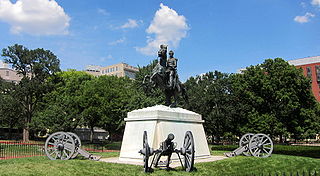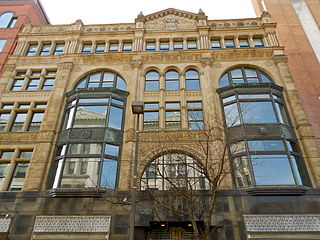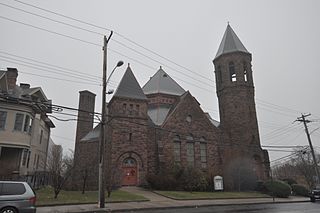
The National Archives Building, known informally as Archives I, is the headquarters of the United States National Archives and Records Administration. It is located north of the National Mall at 700 Pennsylvania Avenue, N.W. in Washington, D.C.. The rotunda entrance is on Constitution Avenue, and the research entrance is on Pennsylvania Avenue. A second larger facility, Archives II, also known as A2, is located in College Park, Maryland.

The Temperance Fountain is a fountain and statue located in Washington, D.C., donated to the city in 1882 by Henry D. Cogswell, a dentist from San Francisco, California, who was a crusader in the temperance movement. This fountain was one of a series of temperance fountains he designed and commissioned in a belief that easy access to cool drinking water would keep people from consuming alcoholic beverages.

The John A. Wilson District Building, popularly known simply as the Wilson Building, houses the municipal offices and chambers of the Mayor and the Council of the District of Columbia. Originally called the District Building, it was renamed in 1994 to commemorate former Council Chair John A. Wilson. Completed in 1908, during the administration of 26th President Theodore Roosevelt, the building is a contributing structure to the Pennsylvania Avenue National Historic Site.

Downtown is the central business district of Washington, D.C., located in Northwest D.C. It is the fourth largest central business district in the United States. The "Traditional Downtown" has been defined as an area roughly between Union Station in the east and 16th Street NW in the west, and between the National Mall on the south and Massachusetts Avenue on the north, including Penn Quarter. However, nowadays, Downtown D.C. usually refers to a larger area, as the DC Office of Planning states:
…most residents, workers, and visitors think of Downtown in a broader sense — including areas as far north as Dupont Circle, as far west as Foggy Bottom, and as far east as Capitol Hill. Only about half of the central city workforce is located within the city’s traditional Downtown.

2000 Pennsylvania Avenue, also known as The Shops at 2000 Penn and Red Lion Row, is a shopping center and eight-story office complex located on Pennsylvania Avenue, NW in Washington, D.C. It forms a busy gateway into the main campus of the George Washington University, which owns the property. As the 2000 Block of Eye Street, NW, the houses were named a DC Landmark and added to the National Register of Historic Places, both in 1977.

The Lafayette Square Historic District is a National Historic Landmark District in Washington, D.C., encompassing a portion of the original L'Enfant Plan for the city's core. It includes the 7-acre (2.8 ha) Lafayette Square portion of President's Park, all of the buildings facing it except the White House, and the buildings flanking the White House to the east and west. The district was designated a National Historic Landmark in 1970.
Woodwardville is an unincorporated community situated in western Anne Arundel County, Maryland, United States, containing 27 structures, 16 of which are historic and included in the Woodwardville Historic District, listed on the National Register of Historic Places in 2003. Most of the structures are located adjacent to Patuxent Road, which runs through the center of the community. On the north end of the district, a small street, 5th Avenue, runs west from Patuxent Road underneath the train tracks. Prior to the establishment of what would be later known as Fort George G. Meade in 1917, the road once continued on to Laurel. Three of the seven buildings along 5th Avenue are historic. Woodwardville's building stock consists principally of late-19th and early-20th century domestic architecture. Good examples of the Bungalow, Foursquare, Tudor Revival, and Queen Anne styles are present, as well as older traditional vernacular classifications such as the I-house. These older forms are supplemented by a handful of post-World War II era structures. Woodwardville also features several public or commercial buildings including a church, a former schoolhouse, the ruins of a store and storage or service buildings associated with the railroad. Many of Woodwardville's older buildings fell into decline following World War II, but in recent years, due to its close proximity to commuter rail service, Woodwardville has evolved into a bedroom community for persons working in Washington and Baltimore. Investment by new residents resulted in the restoration and renovation of many buildings which had formerly been in deteriorating condition. Despite the intense development a mile away in Piney Orchard, this quaint community retains its ability to communicate its historic qualities and distinct sense of place.

The Greensburg Downtown Historic District of Greensburg, Pennsylvania, is bounded approximately by Tunnel Street, Main Street, Third Street, and Harrison Avenue. It consists of 62 buildings on 21.8 acres (8.8 ha), with the most notable buildings from the years 1872-1930. The district's oldest structure (1872) is the former Masonic Temple at 132 South Main Street. The Academy Hill Historic District is directly to the north of downtown Greensburg.

William Lee Stoddart (1868–1940) was an architect who designed urban hotels in the Eastern United States. Although he was born in Tenafly, New Jersey, most of his commissions were in the South. He maintained offices in Atlanta and New York City.

The U.S. Capitol Gatehouses and Gateposts — designed circa 1827 by celebrated architect Charles Bulfinch — originally stood on the grounds of the United States Capitol in Washington, D.C. Two of the gatehouses are listed on the National Register of Historic Places in their new locations.

The Fayetteville Historic Square, in Fayetteville, Arkansas, includes the original Fayetteville post office, the Old Bank of Fayetteville Building, the Lewis Brothers Building, the Mrs. Young Building, and the Guisinger Building. These buildings are listed in the National Register of Historic Places. There are several more recent buildings located on the Square.

The Internal Revenue Service Building is a federal building which serves as the headquarters of the Internal Revenue Service. It is located at 1111 Constitution Avenue, Northwest, Washington, D.C., in the Federal Triangle.

Ephrata Commercial Historic District is a national historic district located at Ephrata, Lancaster County, Pennsylvania. The district includes 36 contributing buildings in the central business district of Ephrata. It has notable examples of the Queen Anne and Italianate architectural styles and buildings designed by noted Lancaster architect C. Emlen Urban. The oldest building dates to 1808 and is the Eagle Hotel. Other notable buildings include the I.G. Sprecher & Sons Hardware (1911), Richard Heitler House (1820), J.W. Yost Liquor Store, Ephrata Railroad Station (1887-1889), U.S. Post Office (1937), Ephrata National Bank (1925), and Grant and Wenger Feed Mill (1924). Located in the district is the separately listed Mentzer Building.

Fairmount Avenue Historic District is a national historic district located in the Spring Garden neighborhood of Philadelphia, Pennsylvania. It encompasses 75 contributing buildings and includes commercial, residential, and industrial properties. Residential buildings include mid- to late 19th-century vernacular Late Victorian rowhouses. Notable commercial and industrial buildings date to the early 20th century through 1930, and are in the early modern and Art Deco styles. Notable non-residential buildings include the A.F. Bernot and Brothers dye works (1900–01), Gaul, Derr, and Shearer building, Security Elevator factory (1925), and the Alemite Lubricator Company offices (1925).

Baldwin & Pennington was the architectural partnership with Ephraim Francis Baldwin (1837–1916) and Josias Pennington (1854–1929) based in Baltimore, Maryland. The firm designed an incredibly large number of prominent structures throughout the Middle Atlantic region, especially as the "house architects" of the Baltimore and Ohio Railroad, including many of its stations and other late 19th century structures for the railroad. Several of their works are listed on the United States' National Register of Historic Places, maintained by the National Park Service of the U.S. Department of the Interior.

The Jefferson Avenue School is an historic American school building that is located in Bristol, Bucks County, Pennsylvania.

The Fifteenth Street Financial Historic District is a historic district in Washington, D.C. that was listed on the National Register of Historic Places in 2006, and modified to the Financial Historic District in 2017. It includes works of Beaux Arts and other architecture by several architects, in 20 contributing buildings built between 1835 and 1940. This building is a linear district of monumental Beaux Arts Classicist commercial buildings notable both individually and as an extraordinarily cohesive ensemble.

The First Baptist Church is a historic church at 126 Washington Avenue in Bridgeport, Connecticut. Built in 1893, it is a distinctive local example of Richardsonian Romanesque architecture, designed by local architect Joseph W. Northrop for a congregation founded in 1837. It was listed on the National Register of Historic Places in 1990.

The Holden–Leonard Workers Housing Historic District encompasses a collection of mill-related tenement houses, plus a former mill store, in Bennington, Vermont. They are located on Benmont and Holden Avenues, near the former Holden–Leonard Mill Complex, Bennington's largest employer in the late 19th century. The district was listed on the National Register of Historic Places in 2011.

The Washington Avenue Commercial Historic District is a nationally recognized historic district located in Iowa Falls, Iowa, United States. It was listed on the National Register of Historic Places in 2012. At the time of its nomination the district consisted of 59 resources, including 42 contributing buildings and 15 non-contributing buildings. The district takes in most of the city's central business district. The buildings here were generally used for retail and office purposes. An opera house and theater are also located here. Around the edges of the district are buildings that housed automobile dealerships. The buildings generally range from one to two stories, but a couple structures are three stories in height. Built between the 1857 and 1960, the buildings are composed of masonry construction. The commercial Italianate and Classical Revival styles are dominant.























